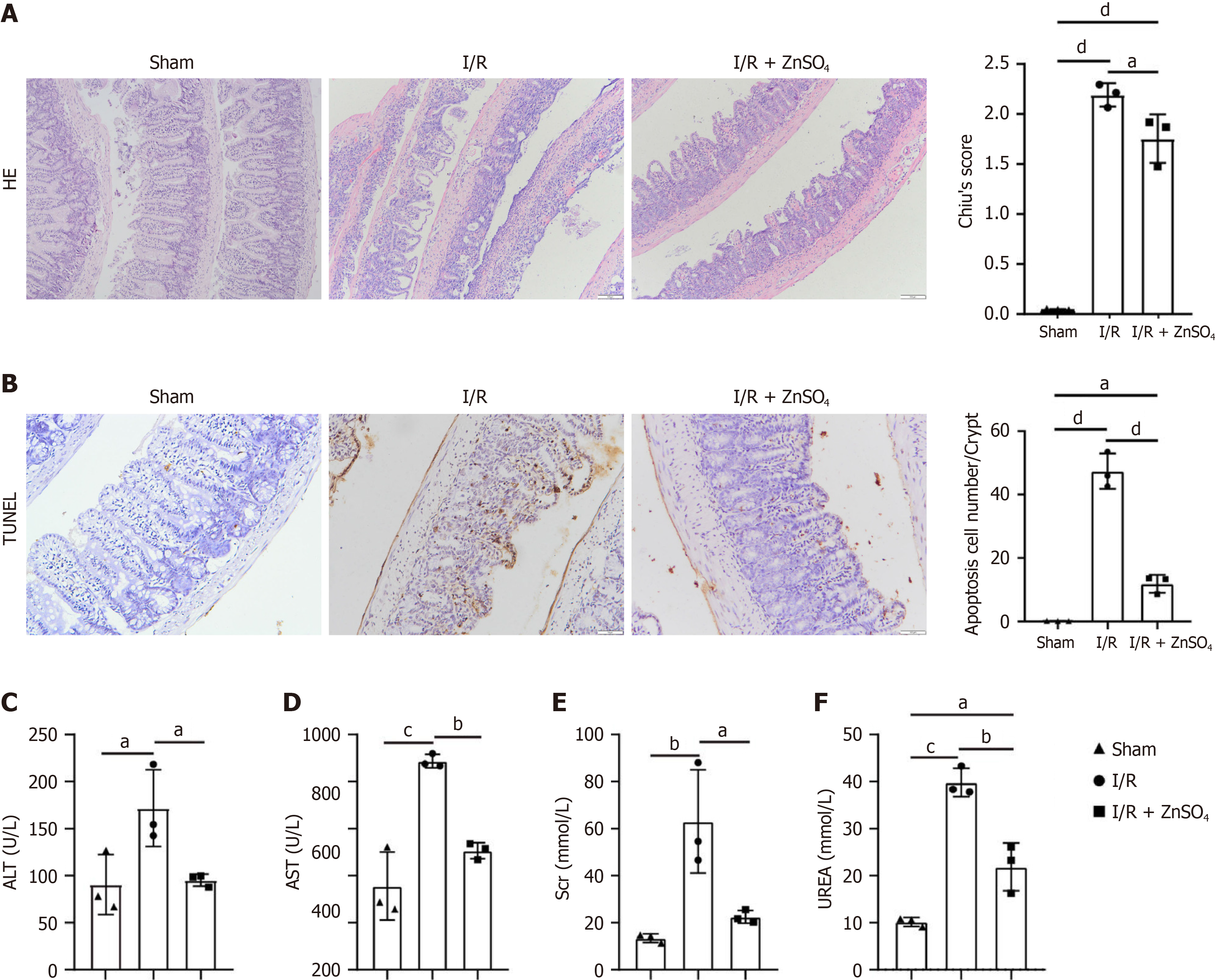Copyright
©The Author(s) 2024.
World J Gastrointest Surg. Dec 27, 2024; 16(12): 3843-3856
Published online Dec 27, 2024. doi: 10.4240/wjgs.v16.i12.3843
Published online Dec 27, 2024. doi: 10.4240/wjgs.v16.i12.3843
Figure 1 Zinc pretreatment mitigates intestinal ischemia-reperfusion injury in superior mesenteric artery occlusion model.
A: Hematoxylin and eosin staining of paraffin-embedded intestinal tissue sections and statistical plot of Chiu’s intestinal injury score. Scale bar, 100 µm; B: TdT-mediated dUTP nick-end labeling staining of intestinal tissue sections and apoptotic cell counts in each group per crypt. Scale bar, 50 µm; C: Serum alanine aminotransferase levels; D: Serum aspartate aminotransferase levels; E: Serum creatinine levels; F: Serum urea levels. The ischemia-reperfusion (I/R) group and the I/R + ZnSO4 group underwent I/R procedures, while the Sham group underwent only abdominal opening. ZnSO4 was administered via intraperitoneal injection at a concentration of 10 mg/kg. All the data are presented as the means ± SEM. aP < 0.05; bP < 0.01; cP < 0.001, dP < 0.0001. TUNEL: TdT-mediated dUTP nick-end labeling; HE: Hematoxylin and eosin; AST: Aspartate aminotransferase; ALT: Alanine aminotransferase; Scr: Serum creatinine; I/R: Ischemia-reperfusion.
Figure 2 Zinc pretreatment mitigates multi-organ damage in abdominal aortic occlusion model.
A: Hematoxylin and eosin (HE) staining of intestinal tissue sections and Chiu’s intestinal injury score. Scale bar, 50 mm; B: HE staining of liver tissue sections and the Suzuki liver Injury score. Scale bar, 20 mm; C: Periodic acid-Schiff staining of kidney tissue sections and renal tubular injury score. Scale bar, 20 mm; D: Serum alanine aminotransferase levels; E: Serum aspartate aminotransferase levels; F: Serum creatinine levels; G: Serum urea levels. The ischemia-reperfusion (I/R) group and the I/R + ZnSO4 group underwent I/R procedures, while the Sham group underwent only abdominal opening. ZnSO4 was administered via intraperitoneal injection at a concentration of 10 mg/kg. All the data are presented as the means ± SEM. aP < 0.05; bP < 0.01; cP < 0.001, dP < 0.0001. HE: Hematoxylin and eosin; AST: Aspartate aminotransferase; ALT: Alanine aminotransferase; Scr: Serum creatinine; I/R: Ischemia-reperfusion. AAO: Abdominal aortic occlusion.
Figure 3 Zinc pretreatment reduces the expression of inflammatory cytokines in tissues in the abdominal aortic occlusion model.
mRNA levels of Il1β, Il6, and TNFα were measured using a qPCR assay in gut, liver, and kidney tissues, respectively. The ischemia-reperfusion (I/R) group and the I/R + ZnSO4 group underwent I/R procedures, while the Sham group underwent only abdominal opening. ZnSO4 was administered via intraperitoneal injection at a concentration of 10 mg/kg. All the data are presented as the means ± SEM. aP < 0.05; bP < 0.01; cP < 0.001, dP < 0.0001. I/R: Ischemia-reperfusion.
Figure 4 Zinc reduces reactive oxygen species production in Caco-2 cells.
A: Caco-2 cells were cultured under hypoxic conditions for 12 hours. After reoxygenation for 3 hours, superoxide dismutase levels were measured; B and C: Caco-2 cells were incubated with DCFH-DA under hypoxia-reoxygenation conditions, and DCF fluorescence was measured to evaluate intracellular oxidative stress. All the data are presented as the means ± SEM. aP < 0.01; bP < 0.0001. SOD: Superoxide dismutase.
Figure 5 Zinc protects small intestinal organoids from hypoxia-reoxygenation injury.
A and B: Small intestinal organoids were cultured for five days, followed by the addition of ZnSO4. After 24 or 48 hours of treatment, the organoids were subjected to 2 hours of hypoxia followed by reoxygenation. Representative images of the organoids are shown; C: Quantification of dead organoids is presented. Scale bar, 200 mm; All the data are presented as the means ± SEM. aP < 0.05.
- Citation: Cheng MZ, Luo JH, Li X, Liu FY, Zhou WJ. Zinc pretreatment for protection against intestinal ischemia-reperfusion injury. World J Gastrointest Surg 2024; 16(12): 3843-3856
- URL: https://www.wjgnet.com/1948-9366/full/v16/i12/3843.htm
- DOI: https://dx.doi.org/10.4240/wjgs.v16.i12.3843













